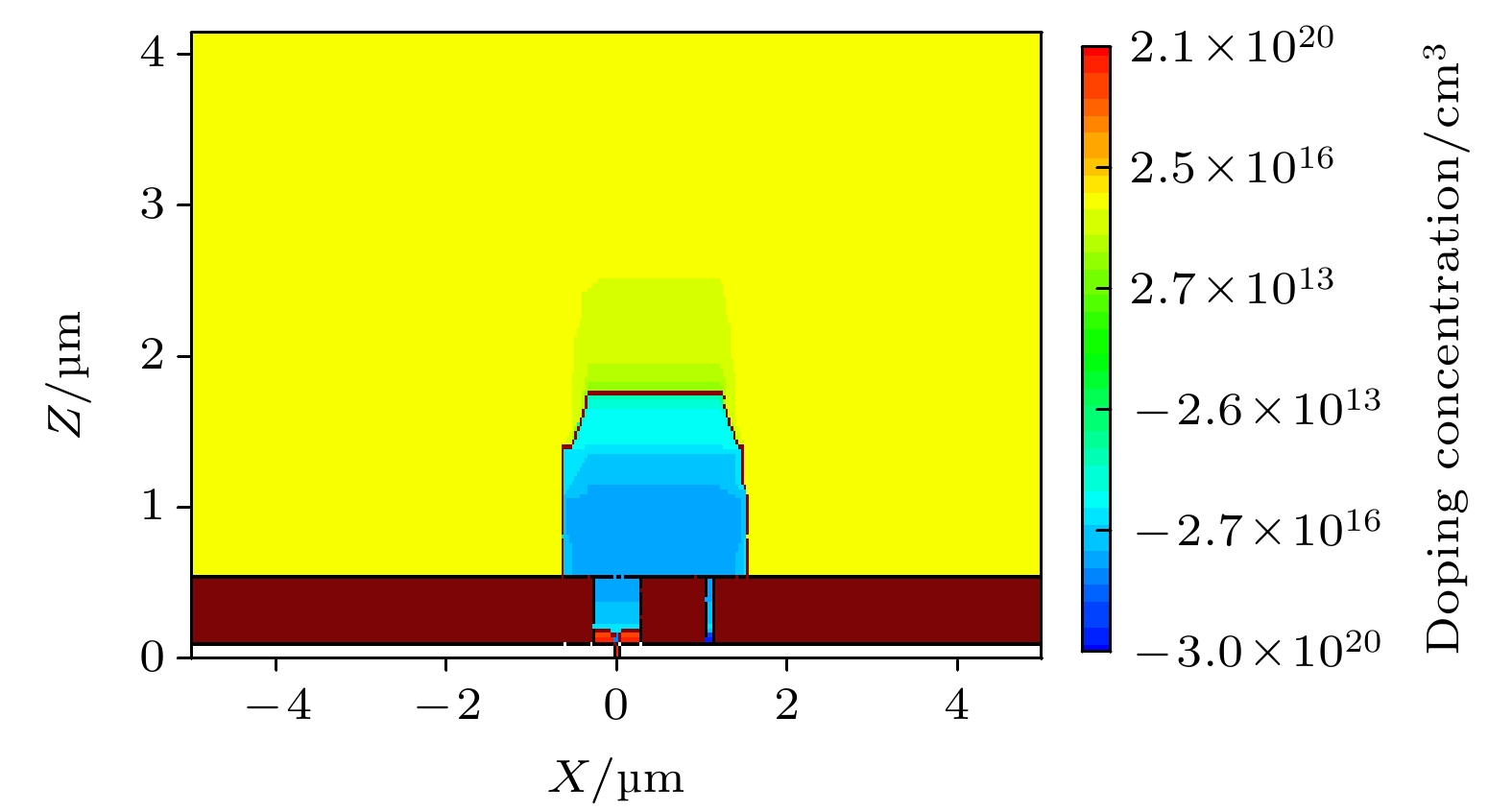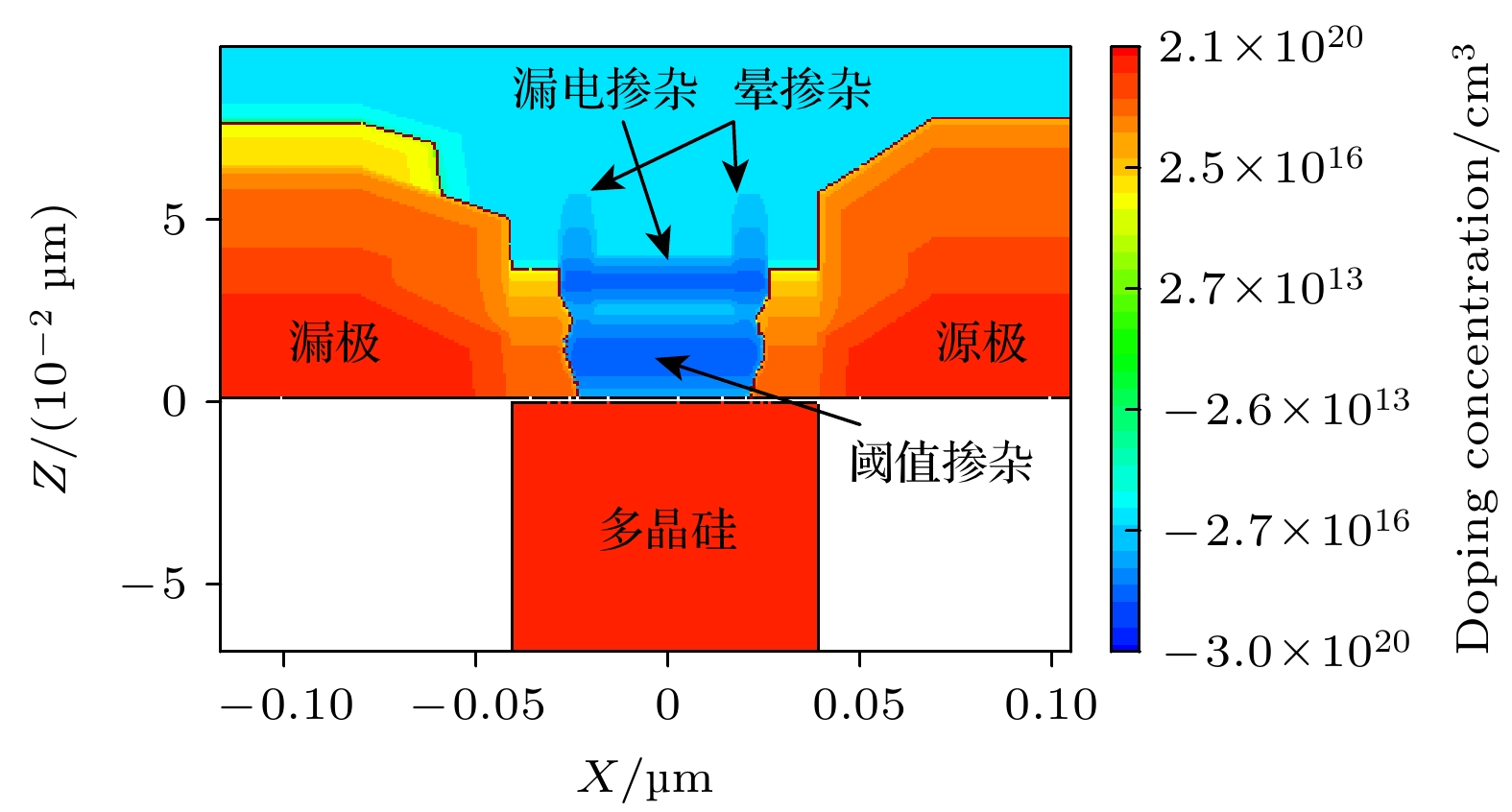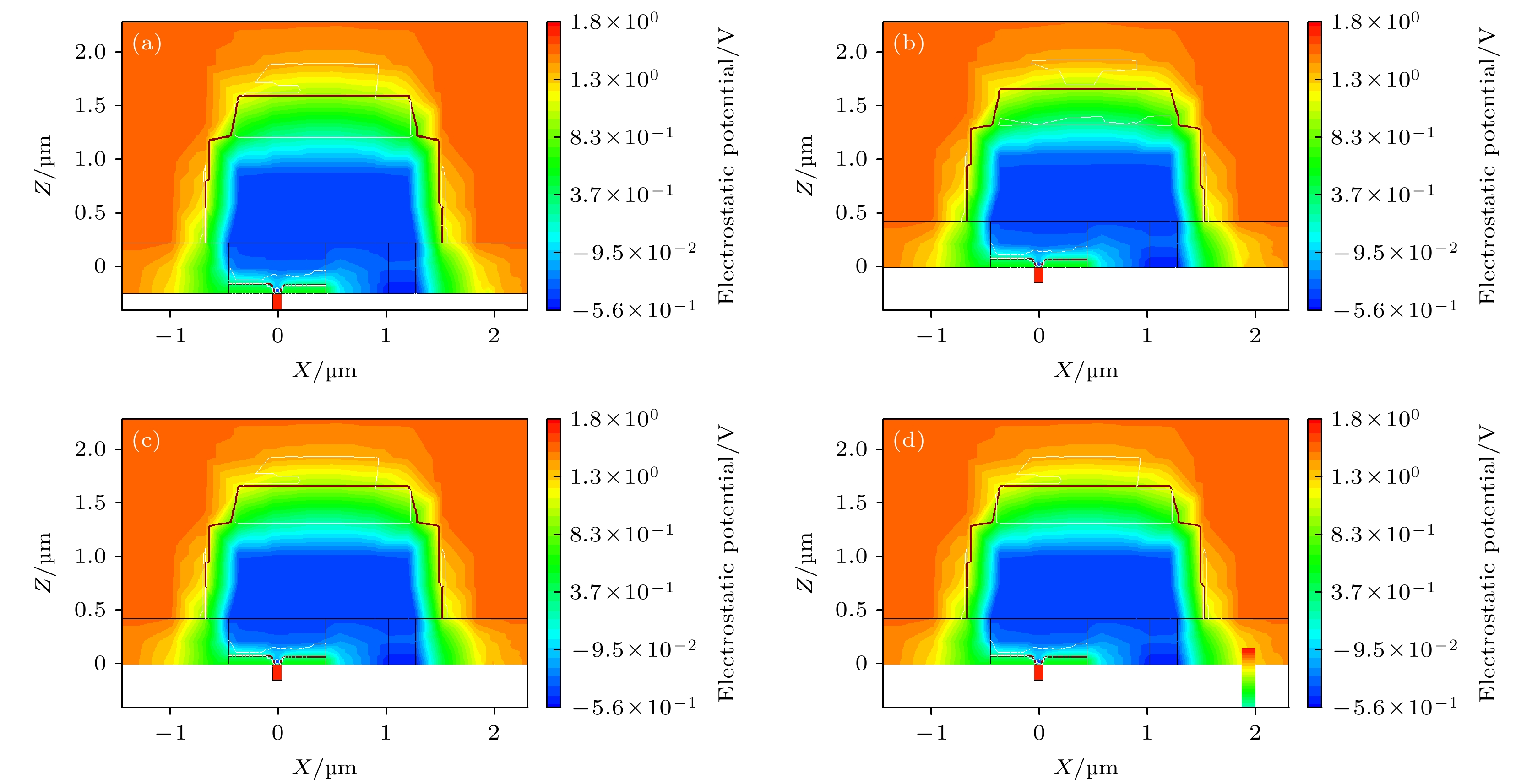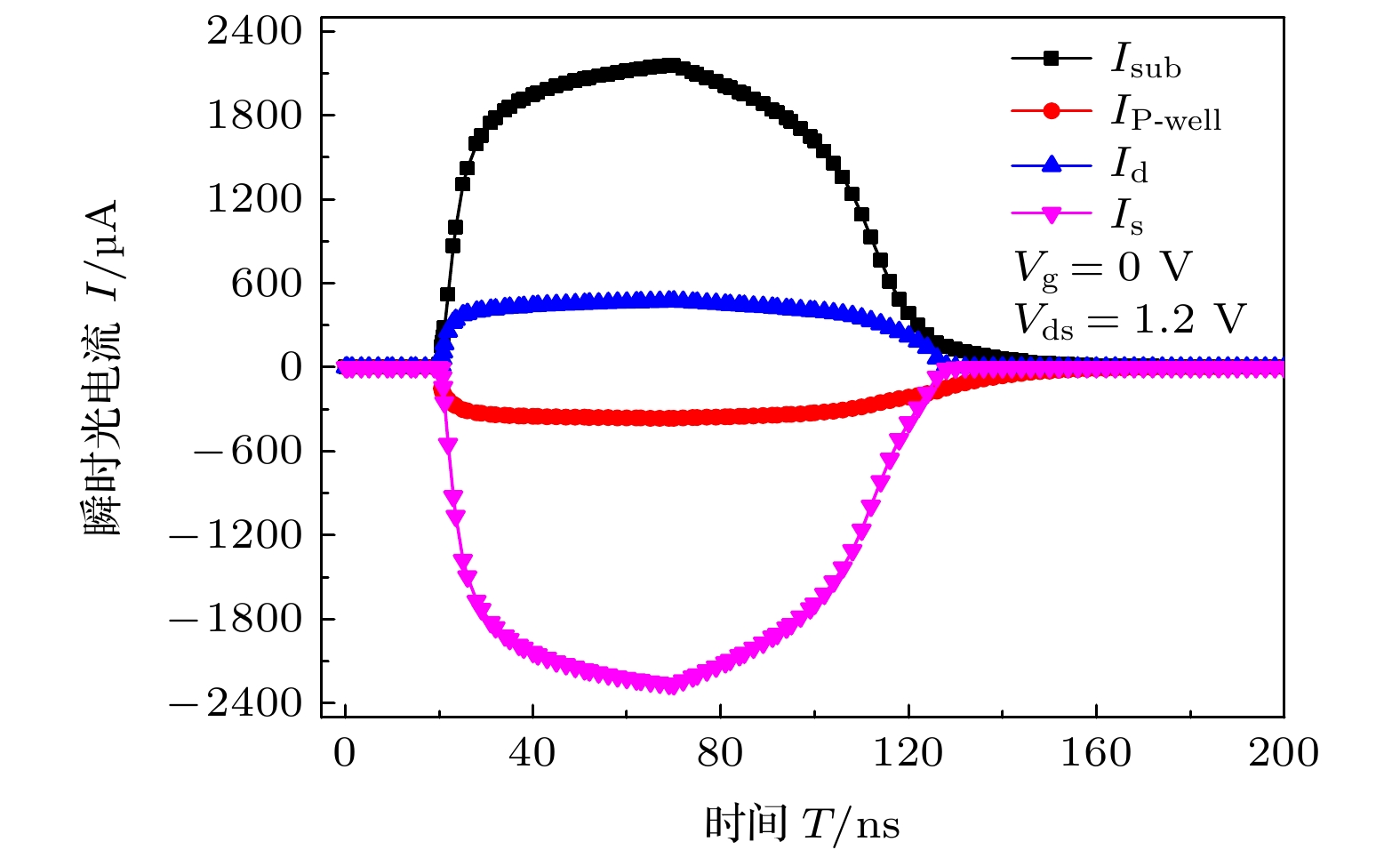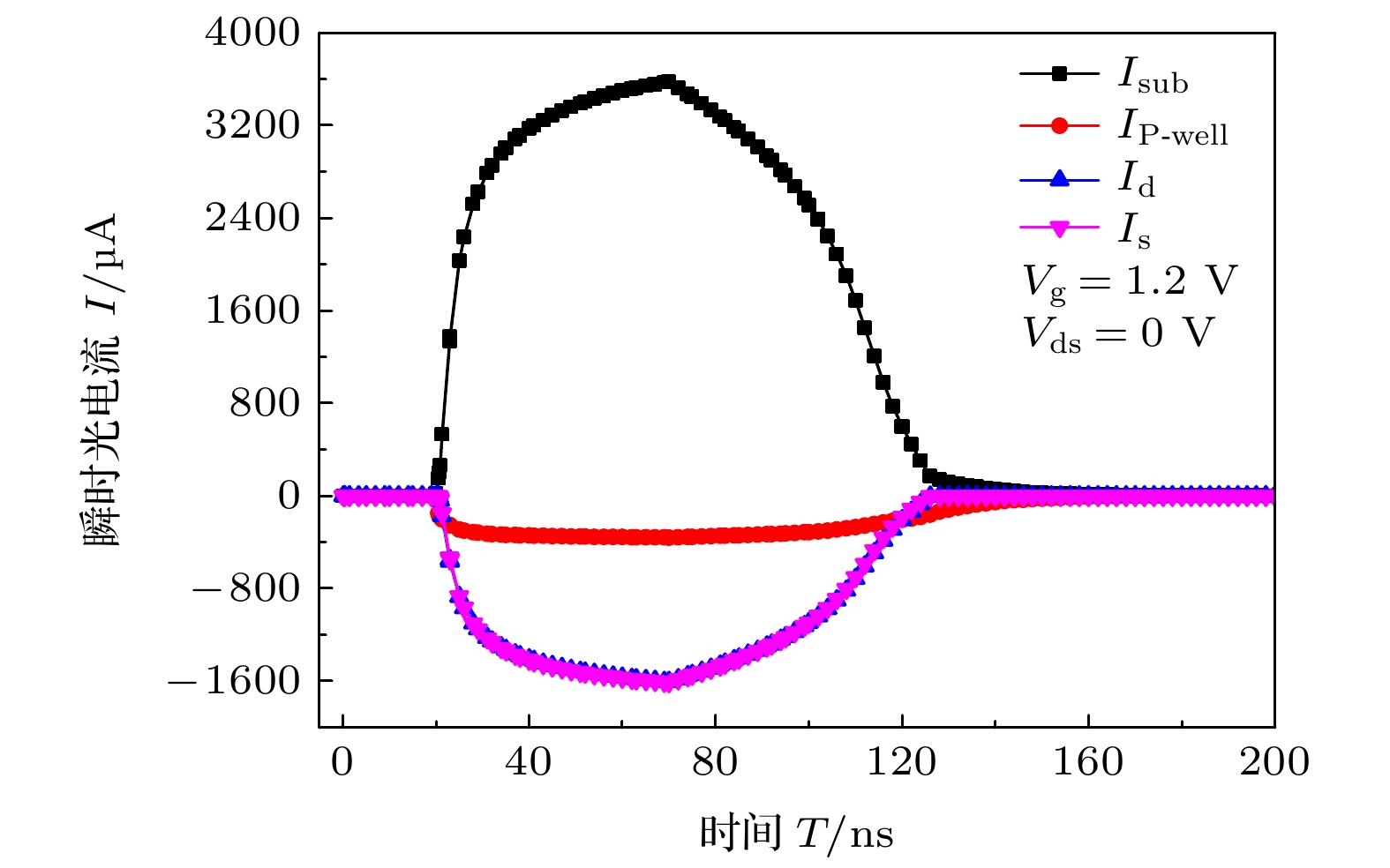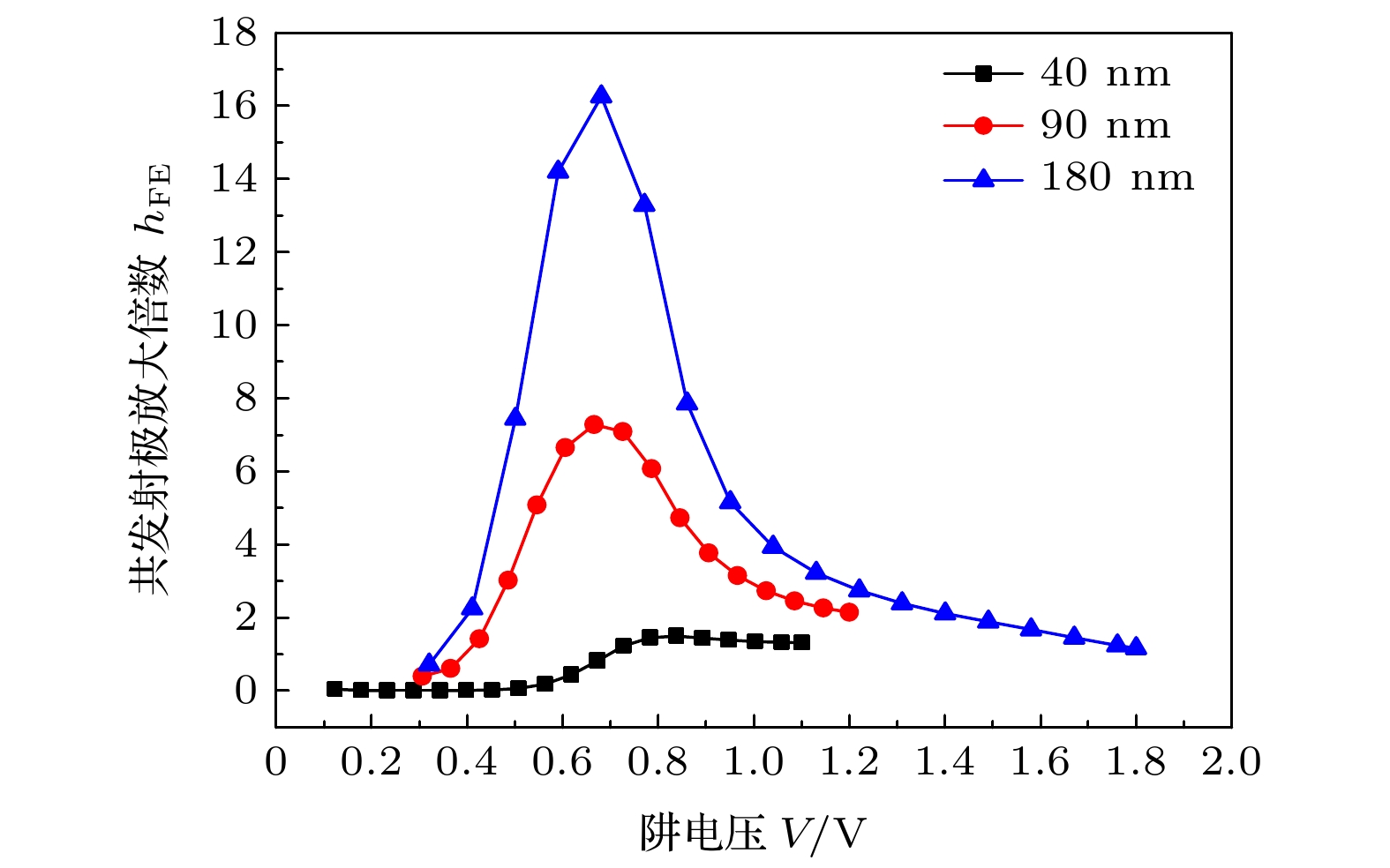-
金属氧化物场效应晶体管作为大规模数字电路的基本单元, 其内部的寄生效应一直以来被认为是影响集成电路在脉冲γ射线辐射环境中发生扰动、翻转以及闩锁的重要因素. 为研究脉冲γ射线诱发N型金属氧化物场效应晶体管内部纵向寄生效应的开启机制, 通过TCAD构建了40, 90以及180 nm 3种不同工艺节点的NMOS晶体管进行瞬时电离辐射效应仿真, 得到了纵向寄生三极管电流增益随工艺节点的变化趋势、纵向寄生三极管的开启条件及其对NMOS晶体管工作状态的影响. 结果表明: 1)脉冲γ射线在辐射瞬时诱发NMOS晶体管内部阱电势抬升是导致纵向寄生三极管开启的主要原因; 2)当纵向寄生三极管导通时, NMOS晶体管内部会产生强烈的二次光电流影响晶体管的工作状态; 3) NMOS晶体管内部纵向寄生三极管的电流增益随工艺节点的减小而减小. 研究结果可为电子器件的瞬时电离辐射效应机理研究提供理论依据.The parasitic effect inside metal oxide field effect transistor regarded as the basic structure of large scale digital circuits, has long been considered as an important factor affecting the disturbance, upset and latchup of integrated circuits in pulsed γ-ray radiation environment. To investigate the turn-on mechanism of vertical parasitic effect in NMOSFET induced by pulsed γ-ray radiation, the 40 nm, 90 nm and 180 nm NMOSFET device models are constructed by TCAD and the normal electrical characteristics are calibrated. The trend of vertical parasitic triode current gain, the turn-on conditions of vertical parasitic triode and their influence on working state of NMOSFET are obtained. The simulation results are shown below. 1) The disturbance of well potential inside NMOSFET induced by pulsed γ-ray radiation is the main reason for the turn-on of vertical parasitic triode. 2) When vertical parasitic triode is turn-on, the large secondary photocurrent will be generated inside NMOSFET which will affect the working state of the transistor. 3) The current gain of vertical parasitic triode in NMOSFET decreases with the technology node decreasing. The results provide a theoretical basis for studying the transient ionizing radiation effects of electronic devices.
-
Keywords:
- transient ionizing radiation effect /
- parasitic effect /
- rise of well potential /
- secondary photocurrent
[1] Wirth J L, Rogers S C 1964 IEEE Trans. Nucl. Sci. 11 24
 Google Scholar
Google Scholar
[2] Enlow E W, Alexander D R 1988 IEEE Trans. Nucl. Sci. 35 1467
 Google Scholar
Google Scholar
[3] Fjeldly T A, Deng Y Q, Shur M S, Hjalmarson H P, Muyshondt A, Ytterdal T 2001 IEEE Trans. Nucl. Sci. 48 1721
 Google Scholar
Google Scholar
[4] Alexander D R 2003 IEEE Trans. Nucl. Sci. 50 565
 Google Scholar
Google Scholar
[5] 赖祖武 1998 抗辐射电子学(北京: 国防工业出版社) 第288—300页
Lai Z W 1998 Radiation Electronics (Beijing: Defense Industry Press) pp288–300 (in Chinese)
[6] Lewis C 1995 Transient Radiation Effects on Electronics (Alexandria: Defense Nuclear Agency) pp200–245
[7] 马强, 林东生, 范如玉, 陈伟, 杨善潮, 龚建成, 王桂珍, 齐超 2010 原子能科学技术 44 545
 Google Scholar
Google Scholar
Ma Q, Lin D S, Fan R Y, Chen W, Yang S C, Gong J C, Wang G Z, Qi C 2010 Atomic Energy Science and Technology 44 545
 Google Scholar
Google Scholar
[8] Oh S C, Lee N H, Lee H H 2012 12th International Conference on Control, Automation and Systems Jeju Island, Korea, October 17–21, 2012 p1233
[9] 王桂珍, 林东生, 齐超, 白小燕, 杨善潮, 李瑞宾, 马强, 金晓明, 刘岩 2014 原子能科学技术 48 2165
 Google Scholar
Google Scholar
Wang G Z, Lin D S, Qi C, Bai X Y, Yang S C, Li R B, Ma Q, Jin X M, Liu Y 2014 Atomic Energy Science and Technology 48 2165
 Google Scholar
Google Scholar
[10] Massengill L W, Diehl-Nagle S E 1985 IEEE Trans. Nucl. Sci. 32 4026
 Google Scholar
Google Scholar
[11] Massengill L W, Diehl-Nagle S E 1986 IEEE Trans. Nucl. Sci. 33 1541
 Google Scholar
Google Scholar
[12] Li J L, Chen W, Li R B, Wang G Z, Yang S C 2019 3rd Internaltional Conference on Radiation Effects of Electronic Devices Chongqing, China, May 29–31, 2019 pp1–4
[13] Boselli G, Reddy V, Duvvury C 2005 43rd Annual International Reliability Physics Symposium San Jose, USA, April 17–21, 2005 p137
[14] Li R B, Chen W, Lin D S, Yang S C, Bai X Y, Wang G Z, Liu Y, Qi C, Ma Q 2012 Sci. Chin. Tech. Sci. 55 3242
 Google Scholar
Google Scholar
[15] Keshavarz A A, Fischer T A, Dawes W R, Hawkins C F 1988 IEEE Trans. Nucl. Sci. 35 1422
 Google Scholar
Google Scholar
[16] Olson B D, Amusan O A, Dasgupta S, Massengill L W, Witulski A F, Bhuva B L, Alles M L, Warrenm K M, Ball D R 2007 IEEE Trans. Nucl. Sci. 54 894
 Google Scholar
Google Scholar
[17] Ahlbin J R, Atkinson N M, Gadlage M J, Gaspard N J, Bhuva B L, Loveless T D, Zhang E X, Chen L, Massengill L W 2011 IEEE Trans. Nucl. Sci. 58 2585
 Google Scholar
Google Scholar
[18] 金晓明, 范如玉, 陈伟, 王桂珍, 林东生, 杨善潮, 白小燕 2010 原子能科学技术 44 1487
 Google Scholar
Google Scholar
Jin X M, Fan R Y, Chen W, Wang G Z, Lin D S, Yang S C, Bai X Y 2010 Atomic Energy Science and Technology 44 1487
 Google Scholar
Google Scholar
[19] Calienes W, Reis R, Anghel C, Vladimirescu A 2014 IEEE 57th International Midwest Symposium on Circuits and Systems Texas, USA, August 3–6, 2014 p655
[20] Wunsch T F, Hash G L, Hewlett F W, Treece R K 1991 IEEE Trans. Nucl. Sci. 38 1392
 Google Scholar
Google Scholar
[21] Dasgupta S 2007 M. S. Thesis (Nashville: Vanderbilt University)
[22] Atkinson N M 2010 M. S. Thesis (Nashville: Vanderbilt University)
[23] Li R B, Wang C H, He C H, Chen W, Li J L, Qi C, Liu Y 2020 Nucl. Instrum. Meth. B 470 32
 Google Scholar
Google Scholar
[24] Neamen D A 2007 Semiconductor Physics and Devices Basic Principles (Beijing: Publishing House of Electronics Industry) pp284–285
-
表 1 不同尺寸NMOS管结构参数与工艺参数
Table 1. Structure and process parameters of NMOS with different feature size.
工艺节点
λ/nm沟道长度
L/nm沟道宽度
W/nm源漏掺杂
/cm3晕掺杂
/cm3多晶硅掺杂
/cm3阈值掺杂
/cm3漏电掺杂
/cm340 40 120 2 × 1020 1.5 × 1019 2 × 1020 7.5 × 1018 7.5 × 1018 90 80 200 2 × 1020 1 × 1018 2 × 1020 8.2 × 1018 8 × 1018 180 180 540 1 × 1020 8 × 1017 1 × 1020 8 × 1018 7 × 1018 -
[1] Wirth J L, Rogers S C 1964 IEEE Trans. Nucl. Sci. 11 24
 Google Scholar
Google Scholar
[2] Enlow E W, Alexander D R 1988 IEEE Trans. Nucl. Sci. 35 1467
 Google Scholar
Google Scholar
[3] Fjeldly T A, Deng Y Q, Shur M S, Hjalmarson H P, Muyshondt A, Ytterdal T 2001 IEEE Trans. Nucl. Sci. 48 1721
 Google Scholar
Google Scholar
[4] Alexander D R 2003 IEEE Trans. Nucl. Sci. 50 565
 Google Scholar
Google Scholar
[5] 赖祖武 1998 抗辐射电子学(北京: 国防工业出版社) 第288—300页
Lai Z W 1998 Radiation Electronics (Beijing: Defense Industry Press) pp288–300 (in Chinese)
[6] Lewis C 1995 Transient Radiation Effects on Electronics (Alexandria: Defense Nuclear Agency) pp200–245
[7] 马强, 林东生, 范如玉, 陈伟, 杨善潮, 龚建成, 王桂珍, 齐超 2010 原子能科学技术 44 545
 Google Scholar
Google Scholar
Ma Q, Lin D S, Fan R Y, Chen W, Yang S C, Gong J C, Wang G Z, Qi C 2010 Atomic Energy Science and Technology 44 545
 Google Scholar
Google Scholar
[8] Oh S C, Lee N H, Lee H H 2012 12th International Conference on Control, Automation and Systems Jeju Island, Korea, October 17–21, 2012 p1233
[9] 王桂珍, 林东生, 齐超, 白小燕, 杨善潮, 李瑞宾, 马强, 金晓明, 刘岩 2014 原子能科学技术 48 2165
 Google Scholar
Google Scholar
Wang G Z, Lin D S, Qi C, Bai X Y, Yang S C, Li R B, Ma Q, Jin X M, Liu Y 2014 Atomic Energy Science and Technology 48 2165
 Google Scholar
Google Scholar
[10] Massengill L W, Diehl-Nagle S E 1985 IEEE Trans. Nucl. Sci. 32 4026
 Google Scholar
Google Scholar
[11] Massengill L W, Diehl-Nagle S E 1986 IEEE Trans. Nucl. Sci. 33 1541
 Google Scholar
Google Scholar
[12] Li J L, Chen W, Li R B, Wang G Z, Yang S C 2019 3rd Internaltional Conference on Radiation Effects of Electronic Devices Chongqing, China, May 29–31, 2019 pp1–4
[13] Boselli G, Reddy V, Duvvury C 2005 43rd Annual International Reliability Physics Symposium San Jose, USA, April 17–21, 2005 p137
[14] Li R B, Chen W, Lin D S, Yang S C, Bai X Y, Wang G Z, Liu Y, Qi C, Ma Q 2012 Sci. Chin. Tech. Sci. 55 3242
 Google Scholar
Google Scholar
[15] Keshavarz A A, Fischer T A, Dawes W R, Hawkins C F 1988 IEEE Trans. Nucl. Sci. 35 1422
 Google Scholar
Google Scholar
[16] Olson B D, Amusan O A, Dasgupta S, Massengill L W, Witulski A F, Bhuva B L, Alles M L, Warrenm K M, Ball D R 2007 IEEE Trans. Nucl. Sci. 54 894
 Google Scholar
Google Scholar
[17] Ahlbin J R, Atkinson N M, Gadlage M J, Gaspard N J, Bhuva B L, Loveless T D, Zhang E X, Chen L, Massengill L W 2011 IEEE Trans. Nucl. Sci. 58 2585
 Google Scholar
Google Scholar
[18] 金晓明, 范如玉, 陈伟, 王桂珍, 林东生, 杨善潮, 白小燕 2010 原子能科学技术 44 1487
 Google Scholar
Google Scholar
Jin X M, Fan R Y, Chen W, Wang G Z, Lin D S, Yang S C, Bai X Y 2010 Atomic Energy Science and Technology 44 1487
 Google Scholar
Google Scholar
[19] Calienes W, Reis R, Anghel C, Vladimirescu A 2014 IEEE 57th International Midwest Symposium on Circuits and Systems Texas, USA, August 3–6, 2014 p655
[20] Wunsch T F, Hash G L, Hewlett F W, Treece R K 1991 IEEE Trans. Nucl. Sci. 38 1392
 Google Scholar
Google Scholar
[21] Dasgupta S 2007 M. S. Thesis (Nashville: Vanderbilt University)
[22] Atkinson N M 2010 M. S. Thesis (Nashville: Vanderbilt University)
[23] Li R B, Wang C H, He C H, Chen W, Li J L, Qi C, Liu Y 2020 Nucl. Instrum. Meth. B 470 32
 Google Scholar
Google Scholar
[24] Neamen D A 2007 Semiconductor Physics and Devices Basic Principles (Beijing: Publishing House of Electronics Industry) pp284–285
计量
- 文章访问数: 6362
- PDF下载量: 69
- 被引次数: 0













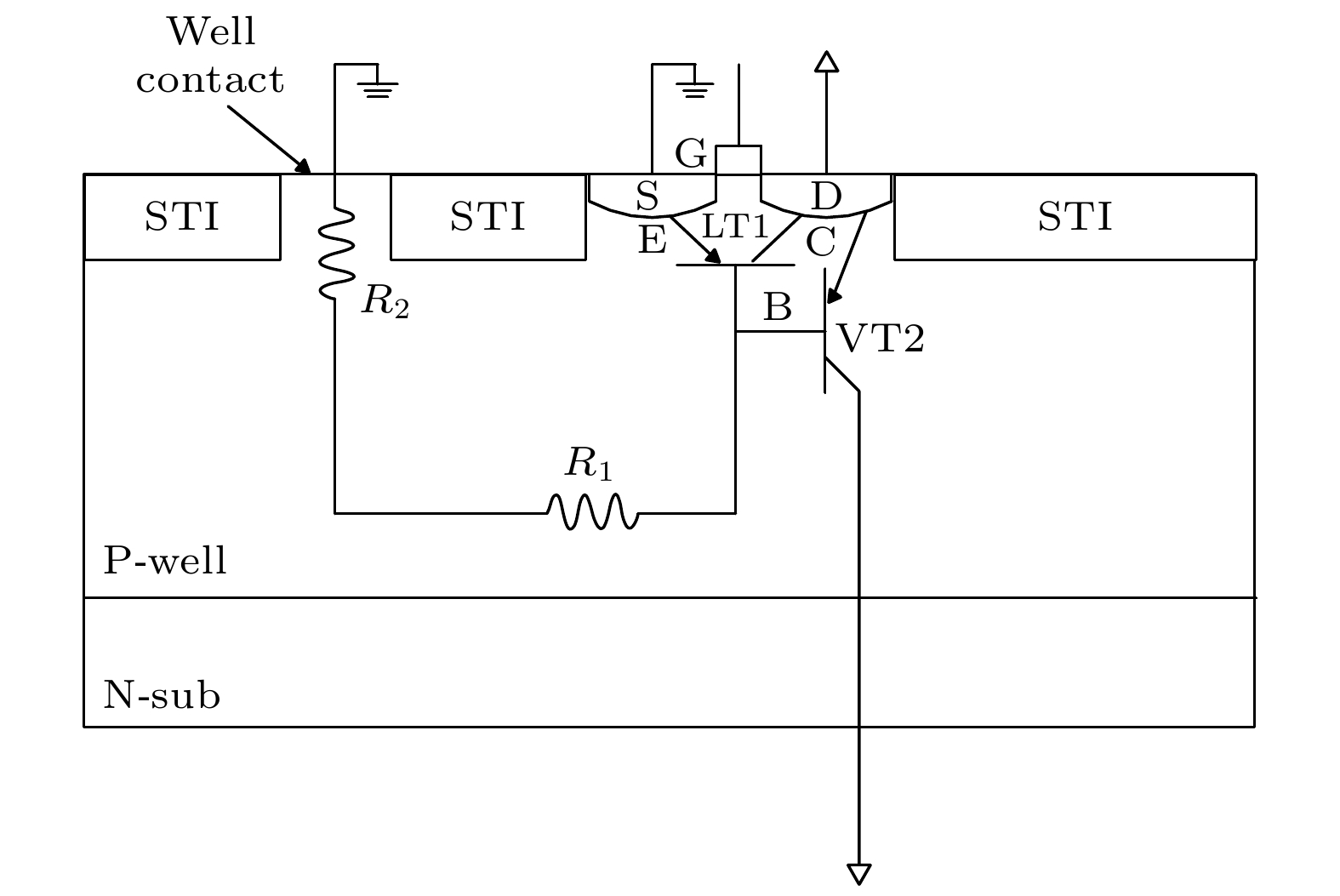
 下载:
下载:
